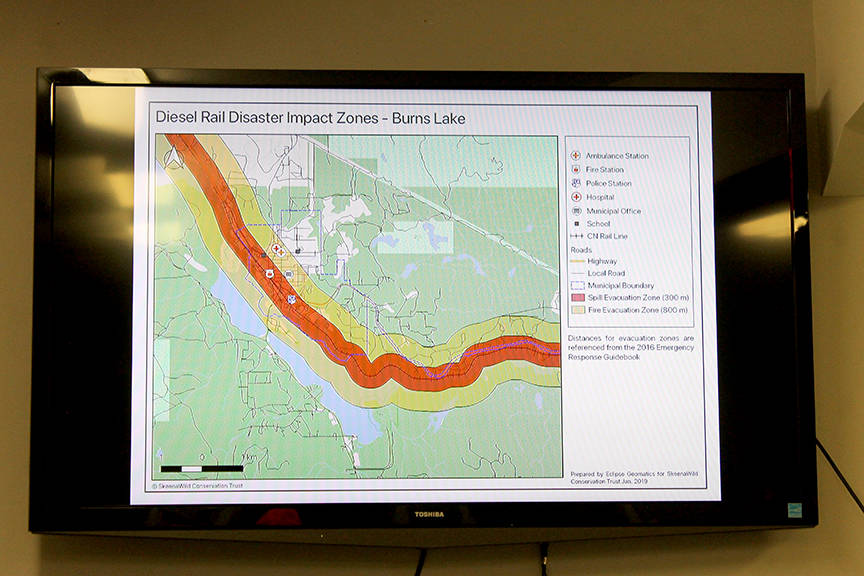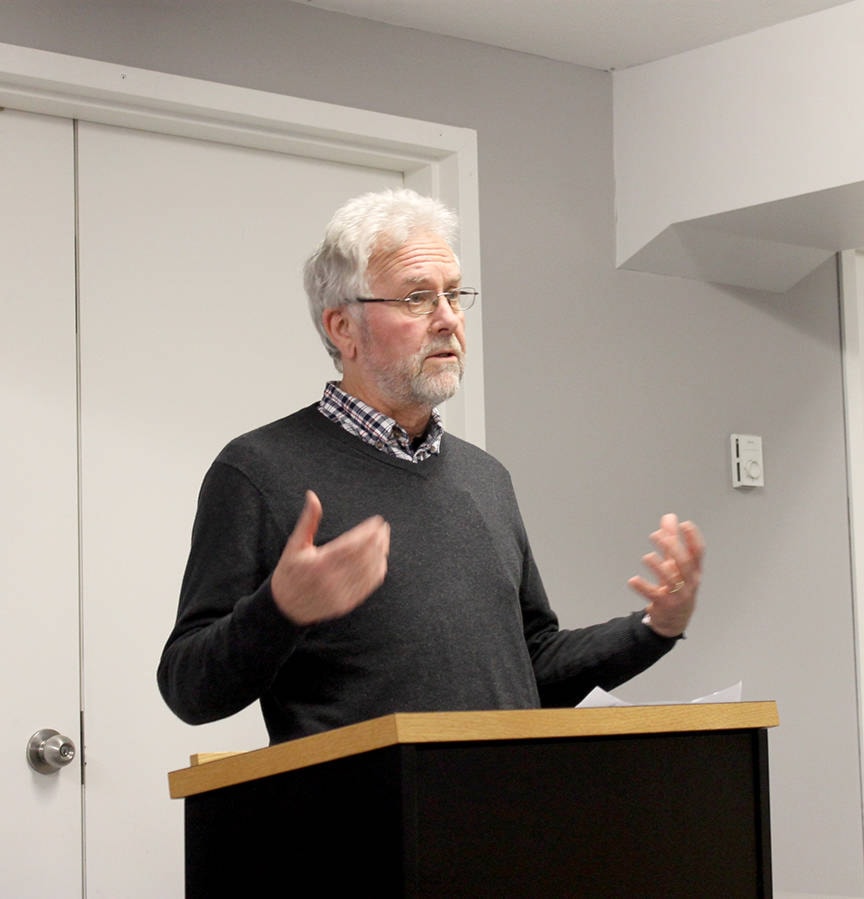Are we safe in Burns Lake, if an accident involving dangerous substances occurred along the railway line that goes through the village?
Professor Bruce Campbell asked the same question for the presentation he gave on Jan. 21 in the Burns Lake Public Library, following the publication of his new book The Lac-Mégantic Rail Disaster: Public Betrayal, Justice Denied.
That accident in Lac-Megantic, Quebec on July 6, 2013 killed 47 people after a train of 72 train cars of crude oil derailed, crashed and exploded.
Campbell’s question is aimed at drawing attention to railway safety in Canada, especially when so many trains go through population centres carrying large volumes of oil, propane, methanol and other chemicals.
“I support vibrant and safe railways and railway workers. I support a strong and well-resourced regulator that has the health and safety of citizens as its priority,” Campbell said at the start of his talk.
The Lac-Megantic disaster was the result of a long process of loosened safety regulations enabled by corporate and government cultures that prioritized profits over strong regulatory structures, the Ottawa-based writer explained.
He went back to 1988 when Canadian railways drafted rail operating rules, then moved on to 1995 when the budgets of Transport Canada were cut back, and when Canadian National (CN) Railway was privatized.
Safety management systems diminished in 2001 when rail companies were permitted to self-regulate.
Stephen Harper’s Conservative government was suspicious of regulations and wanted them reduced.
“For the Conservatives it was job-killing, investment-killing regulation and they did a number of things that amounted to more pressure on the regulator and red tape for the regulator,” Campbell said.
By 2012 “the probability of an accident was growing. At this point it was Russian roulette, more of a question of ‘when’ not ‘if.’”
After the doomed train, owned by Montreal, Maine and Atlantic Railway (MMA) left North Dakota on June, 30 2013, the engineer noticed major problems in one of the train’s locomotives. The train also had only one operator, and the railway track conditions were shoddy in many parts.
Following the disaster, regulators and authorities took some immediate actions, including prohibiting trains operated by only one person, and taking out of commission the older models of train cars - such as those of the Lac-Megantic disaster - “which were essentially pop cans on wheels,” Campbell said. “It took something like this for them to get rid of them.”
But Campbell lamented that the responses by safety and railway authorities have been insufficient.
Three railways workers faced charges of criminal negligence but company executives - whom Campbell said are the “villains” in his book - including former CEOs Edward Burkhardt (of MMA) and Hunter Harrison (of Canadian Pacific) were charged with much lesser crimes.
“No one from the minister on down was held accountable.”
Almost six years after the disaster, Campbell said the government still isn’t giving regulators enough resources and continues to take Harper’s approach to regulation: “The one for one rule - you propose one rule, you’ve got to take one out.”
Oil continues to be transported by rail at volumes of up to 500,000 barrels per day.
“The prime minster has argued for pipeline expansion because they’re safer than dangerous rail. Well no, the answer is proper regulation,” Campbell said. “That’s his mandate. It’s under his control. They’re not fully addressing the risks. Have the lessons been learned? My answer is no and the window is still open for history to repeat itself.”
But some people have heeded the lessons, and a group of citizen watchdogs in Lac-Megantic are the “heroes” in Campbell’s book.
The group, one of whom is a survivor of the disaster and suffered skin burns, inspects train lines in the area, brings in independent experts to evaluate tracks and has installed video cameras to monitor passing trains carrying dangerous chemicals.
“They’re pushing for a judicial inquiry given that there’s all kinds of unanswered questions. They’ve got a parliamentary petition going.”
Following Campbell’s presentation, Smithers environmental activist Dan Mesec delivered a presentation on proposed projects by Vopak Pacific Canada, AltaGas and Pacific Traverse that in total would see as much as 350 rail cars of diesel, propane and methanol pass through northern British Columbia daily.
READ MORE: Is Terrace prepared for a rail disaster?
“There have been inquiries with CN to see what they’re actually transporting in these trains and also at what time. They sent back a letter in response and they refused to divulge any of that information, citing security issues,” Mesec said.
Mesec also showed three maps of Burns Lake and the evacuation zones for diesel, propane and methanol accidents along the railway line.
http://www.saferail.ca has more information on railway maps, safety and emergency preparedness.

